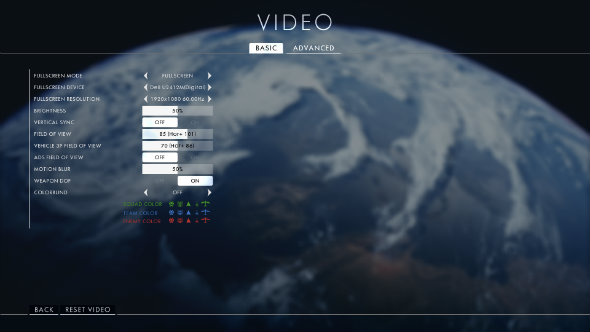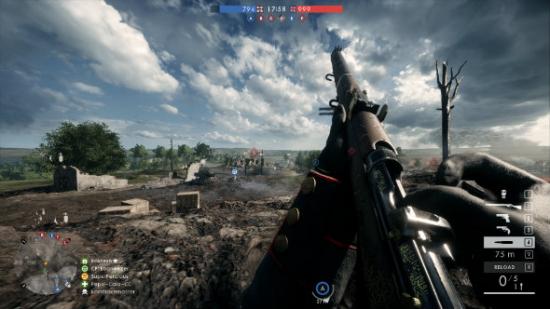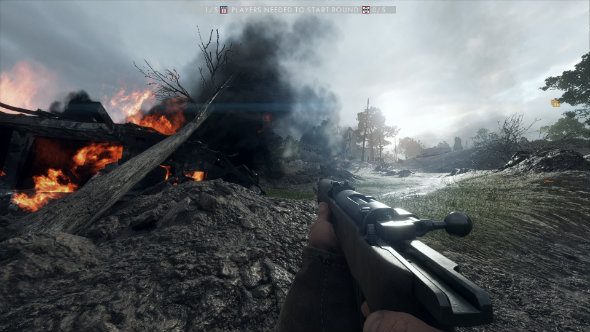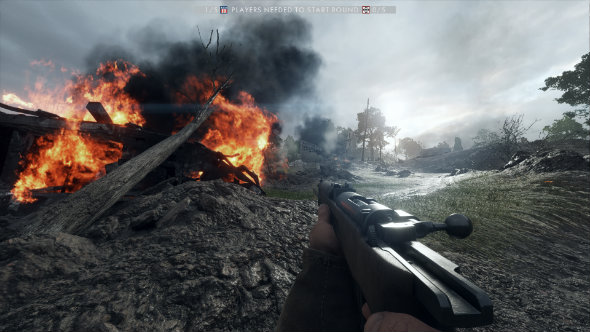2016’s blockbuster finale begins with Battlefield 1, and the gaming world waits with bated breath to analyse its performance. DICE games always set a new bar for graphical fanciness, but Battlefield 4 was infamously riddled with bugs and netcode performance issues. Naturally, people won’t be looking to give Battlefield 1 an easy ride.
Need a helping hand getting started? Try our Battlefield 1 classes guide.
So how does DICE’s World War 1 epic perform on PC? Lets saddle up and find out.
Tested on an Intel i7 3770k @ 3.50 GHz, 16 GB of RAM, Nvidia GTX 1060, Windows 10.
Before we dive into the graphical performance as we usually would for a port review, let’s discuss Battlefield 1’s online stability. Public servers are currently live, although the game isn’t as populated as it will eventually be due to only being available on Origin Access right now. Still, we’re getting a solid look at the game’s online performance, and the good news is that we’re not seeing a repeat of 2013’s fiasco.
DICE would certainly have been terrified of a Battlefield 4 situation, and so have clearly doubled down on efforts to make sure issues like sound cut-outs, excessive rubber-banding, and server disconnects are absent. So far my experiences with Battlefield 1 are exactly what one would expect from a multiplayer game: you connect and you get on with it. Further time and analysis will reveal if hitboxes are properly assigned and no doubt balance passes are in the game’s future, but for pure stability, Battlefield 1 seems ruggedly solid.
Moving on to more traditional port review fare, you’ll find a very acceptable collection of PC graphics settings in the video menu. Split into basic and advanced screens, the former will allow simple changes such as resolution, vsync, and field of view (which details both width and height), while the advanced screen provides ten configurable elements.

These elements can be selected through presets – ultra, high, medium, or low – or individually tailored with a ‘custom’ setting. Available to tweak are settings such as texture, lighting, effects, and mesh quality, ambient occlusion, and antialiasing. There’s also the ability to alter the scale of both the UI and resolution, which are welcome additions.

For colourblind players, a HUD option allows you to select a palette that is clearly visible, making identifying allies, enemies, and objectives easier. It completes a set of PC graphical options that’s exactly what we’d hope for in a good PC port.
Elsewhere you’ll find a complete key-mapping menu that allows two sets of keys to be assigned for all functions.
A great set of menu options means nothing without good performance though, so let’s try out the game on the four main presets.
Ultra
With all guns blazing on ultra, Battlefield 1 looks incredible. There’s no denying the spectacle the series is known for, and this certainly feels like a step-up for DICE. The situation used for these screenshots shows off a variety of effects: fire, lighting, terrain, and texture work. In freezeframe the game doesn’t look as detailed and dynamic as it does in action, but you can tell from the image above that there’s some serious graphical technology at play in this year’s rendition of the Frostbite engine.
Notable pretty elements are in the roughness of the muddy ground to the bottom right, the lighting on the weapon (which highlights the scratches and buffing of the metal components) and the general accomplishment of the meshes. At these highest settings, smoke and lighting effects are soft and natural, textures are crisp, and everything runs at a very acceptable 90-100fps. Pop-in does stain the experience, with large sections of ground textures appearing very smeared until seen close up, but draw distances on physical objects remain solid.
High
Reducing the settings down a notch to high makes very little impact to the graphical quality of the game. The above screenshot is near identical to the previous one, with the same levels of detail in textures, terrain, and effects work. The shadows appear to be slightly harsher on the rifle’s metalwork, but aside from that you’ve still got a very pretty image to behold.
Performance does see a notable boost though: by sacrificing seemingly nothing, you can gain another dozen or so frames, with the rates fluctuating between 100 and 120fps. Pop-in is also reduced, limited mostly to smaller items and texture decals like bullet holes. If you have a similar system to the specs listed at the top of this article, then high is the setting to go for.
Medium
At medium we start to see an impact as graphical quality is traded for performance. Lighting isn’t quite as natural as on the higher presets, looking somewhat flatter. Far-away terrain, such as that mound in the middle-distance on the right, lacks the detail of close-up ground. The gun textures lack realism, looking somewhat flat and missing the detail in the metal and wood grain. This is further dampened by the less complex lighting, which makes the metal look matte rather than shiny. In exchange for such sacrifices though, you can attain frame rates in the 140s, ensuring a super-smooth experience. Medium is also the setting that provides the least texture pop-in.
Low
For those with less powerful machines, low settings will dial back quite a few graphical tricks in exchange for a performance boost. As you can see in the screenshot, there’s a far more obvious change across all elements. The lighting feels washed out, the textures have far less detail, and the actual physical makeup of the ground loses a lot of complexity as tessellation effects are removed. You can see on the mud by the crashed tank and on the slope to the right that the ground is flatter and lacking the bumpy muddiness of higher pre-sets. Pop-in also quite prevalent on low, which is unexpected considering the reduction in graphical quality. The overall result isn’t horrific though, and in motion it still looks pretty solid, if a bit basic. For those with capable set-ups, using the low preset will bag you between 150 and 180fps.
In some ways, the actual basic performance of Battlefield 1 was never in question. DICE have a history of being very kind to the PC, with the majority of the Battlefield series having being showcased at events on our format. Battlefield 1 joins a family of very good PC games, with exactly the kind of options you’d expect it to sport. It’s a beefy game though, so you’ll ideally want to rig with sharpened teeth.
The biggest question lies in server and online support, though. As more people play, servers will take more strain, and that’s where problems can lie. It seems like we’re clear of the launch plague that Battlefield 4 suffered from, but DICE need to be ready to respond to any issues that may come as the population increases, and be in a position to fix things much faster than last time. Should they be able to do that, Battlefield 1 will perform well for its presumably long lifetime.




